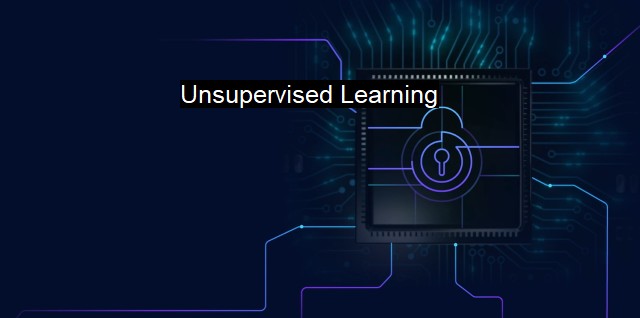What is Unsupervised Learning?
Unsupervised Learning for Antivirus and Malware Detection in Cybersecurity: Advantages and Applications
Unsupervised learning is a type of machine learning algorithm that involves input data without labeled responses. It is analogous to the process of learning through exploration, where the learner is supplied a mountain of information and expected to organize it sensibly without any specific guidance on what to look for. Thus, the key characteristic of unsupervised learning is the absence of a supervisor or a teacher. This kind of machine learning is heavily employed in the domain of cybersecurity and antivirus applications due to its unique ability to detect anomalies and unknown patterns in data.Massive amounts of data are analyzed daily to detect suspicious activities and encounter new threats. It’s impossible for humans to sift through countless lines of data from hundreds of different sources to discover potential security breaches. This is where unsupervised learning comes into play. Unlike supervised learning algorithms that thrive on past knowledge, unsupervised learning dissects raw, unclassified data and identifies patterns based on inherent similarities and differences in the information. This self-discovery aspect is ideal for tackling challenging cybersecurity threats like Zero-Day Attacks or Advanced Persistent Threats that weren’t previously identified.
Unsupervised Learning also helps firewall and intrusion detection systems to self-learn and enhance their capabilities, thus, creating a reactive shield covering the sensitive data of a network or an organization. Without any predefined set of rules, firewalls equipped with unsupervised learning can be trained on various batches of network packets. These packets may contain a mixture of harmless legitimate and potentially malicious traffic that, when investigated using unsupervised machine learning models, can label them into respective ‘benign’ or ‘malicious’ groupings.
In the realm of antiviruses, unsupervised learning can uncover hidden structures in datasets that normal antivirus software might miss. As the data input is not labeled, the antivirus program uses anomaly detection using clustering algorithms to spot trends and patterns usually invisible. It dissects malware behaviors and groups them by associated patterns or anomalies. Once these patterns are identified, antiviruses can predict a file's malicious claims based on the similar patterns identified. In the absence of unsupervised learning, new-age malware which re-engineering itself continuously might escape detection by conventional signature-based antiviruses.
Clustering, one of the fundamental techniques of unsupervised learning involves segregating datasets into exclusive groups or clusters, such that items inside each cluster are more similar to each other than items of different clusters. The algorithm scrutinizes the dataset and groups it into distinguishable clusters, based on their properties or features -- a critical attribute in assisting cybersecurity teams in extracting valuable insight and intelligence from volumes of cyber incident-related data.
The ability for unsupervised learning to identify novel patterns makes it resilient to cyber-criminals' innovative and evolving attack vectors. Another significant factor making unsupervised algorithm a treasure trove is that it functions well when negatives outnumber positives, a bitter truth in cybersecurity issues where breaches are frequent but the incidents of successful breaches are relatively smaller.
Unsupervised learning presents significantly improved and futuristic cybersecurity solutions amidst an escalating cyber threat landscape. It helps avoid the need for costly and often incomplete manual rule-setting, intrusions identification, and scanning of potential malware, thus stepping up the game of defending against cyber threats. As the field of AI and machine learning further develops, so too will the efficiency and effectiveness of using unsupervised learning techniques in cybersecurity.

Unsupervised Learning FAQs
What is unsupervised learning in the context of cybersecurity and antivirus?
Unsupervised learning is a type of machine learning where the algorithm is given unlabelled data to find patterns and relationships on its own. In the context of cybersecurity and antivirus, unsupervised learning algorithms can be used to analyze large volumes of data to detect malicious activities, anomalies, or unknown threats.What are the benefits of using unsupervised learning in cybersecurity and antivirus?
One benefit of using unsupervised learning is the ability to identify new threats that were not previously known or labeled. This is important in cybersecurity and antivirus as threats are constantly evolving and changing. Unsupervised learning can also help reduce false positives and provide more accurate and relevant alerts to security analysts.What are some common unsupervised learning algorithms used in cybersecurity and antivirus?
Some common unsupervised learning algorithms used in cybersecurity and antivirus include k-means clustering, hierarchical clustering, principal component analysis (PCA), and anomaly detection. These algorithms can be applied to various types of data such as network traffic, system logs, and user behavior to identify patterns and anomalies that may indicate a security threat.What are some challenges of using unsupervised learning in cybersecurity and antivirus?
One challenge of using unsupervised learning in cybersecurity and antivirus is the need for domain expertise and labeling of data. While unsupervised learning algorithms can detect anomalies and patterns, they may not always identify if these patterns are benign or malicious. Security analysts must have domain expertise to interpret the results of the algorithm and determine if further investigation is necessary. Additionally, labeling data for unsupervised learning can be time-consuming and costly.| | A | | | B | | | C | | | D | | | E | | | F | | | G | | | H | | | I | | | J | | | K | | | L | | | M | |
| | N | | | O | | | P | | | Q | | | R | | | S | | | T | | | U | | | V | | | W | | | X | | | Y | | | Z | |
| | 1 | | | 2 | | | 3 | | | 4 | | | 7 | | | 8 | | |||||||